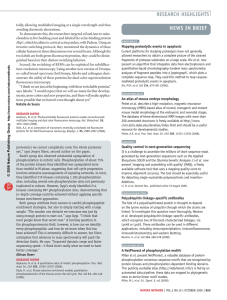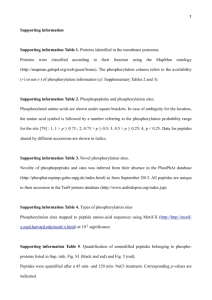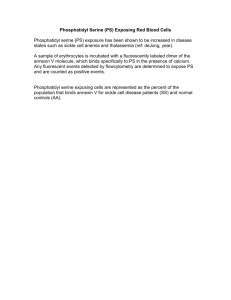Chemical & Engineering News: Science & Technology Concentrates
advertisement
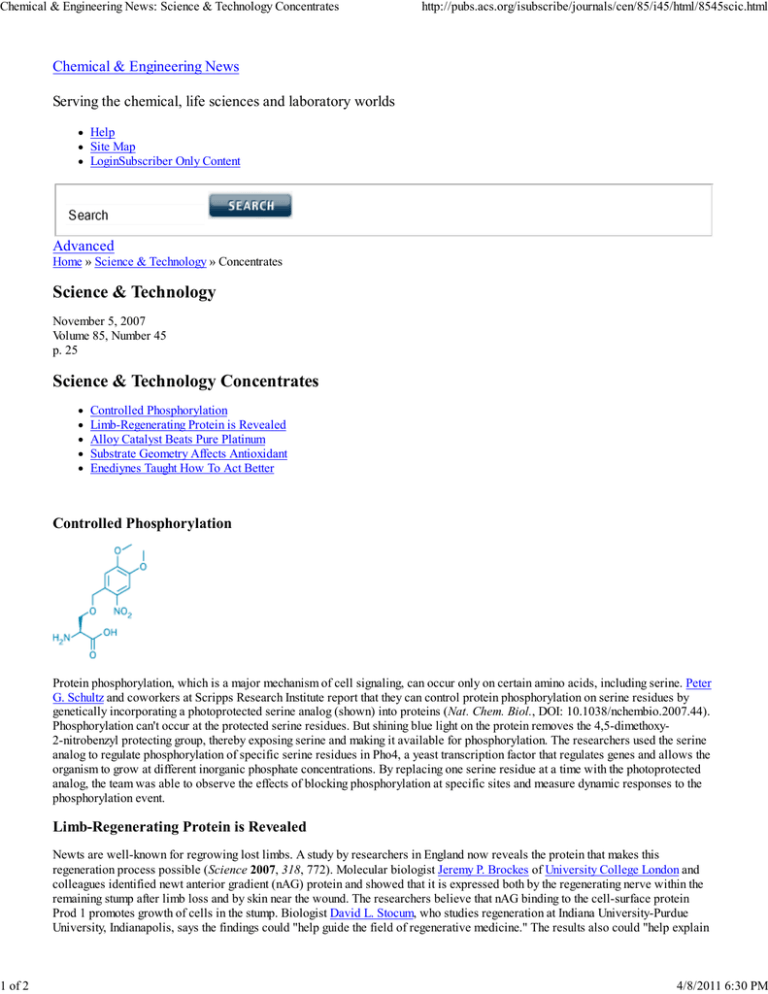
Chemical & Engineering News: Science & Technology Concentrates http://pubs.acs.org/isubscribe/journals/cen/85/i45/html/8545scic.html Chemical & Engineering News Serving the chemical, life sciences and laboratory worlds Help Site Map LoginSubscriber Only Content Advanced Home » Science & Technology » Concentrates Science & Technology November 5, 2007 Volume 85, Number 45 p. 25 Science & Technology Concentrates Controlled Phosphorylation Limb-Regenerating Protein is Revealed Alloy Catalyst Beats Pure Platinum Substrate Geometry Affects Antioxidant Enediynes Taught How To Act Better Controlled Phosphorylation Protein phosphorylation, which is a major mechanism of cell signaling, can occur only on certain amino acids, including serine. Peter G. Schultz and coworkers at Scripps Research Institute report that they can control protein phosphorylation on serine residues by genetically incorporating a photoprotected serine analog (shown) into proteins (Nat. Chem. Biol., DOI: 10.1038/nchembio.2007.44). Phosphorylation can't occur at the protected serine residues. But shining blue light on the protein removes the 4,5-dimethoxy2-nitrobenzyl protecting group, thereby exposing serine and making it available for phosphorylation. The researchers used the serine analog to regulate phosphorylation of specific serine residues in Pho4, a yeast transcription factor that regulates genes and allows the organism to grow at different inorganic phosphate concentrations. By replacing one serine residue at a time with the photoprotected analog, the team was able to observe the effects of blocking phosphorylation at specific sites and measure dynamic responses to the phosphorylation event. Limb-Regenerating Protein is Revealed Newts are well-known for regrowing lost limbs. A study by researchers in England now reveals the protein that makes this regeneration process possible (Science 2007, 318, 772). Molecular biologist Jeremy P. Brockes of University College London and colleagues identified newt anterior gradient (nAG) protein and showed that it is expressed both by the regenerating nerve within the remaining stump after limb loss and by skin near the wound. The researchers believe that nAG binding to the cell-surface protein Prod 1 promotes growth of cells in the stump. Biologist David L. Stocum, who studies regeneration at Indiana University-Purdue University, Indianapolis, says the findings could "help guide the field of regenerative medicine." The results also could "help explain 1 of 2 4/8/2011 6:30 PM Chemical & Engineering News: Science & Technology Concentrates http://pubs.acs.org/isubscribe/journals/cen/85/i45/html/8545scic.html why mammals have limited regrowth abilities, because the nerve sheath may not produce nAG, or cells cannot respond to it because they lack Prod 1," he notes. "But it is more likely that many other factors are missing as well." Alloy Catalyst Beats Pure Platinum Chemical engineers at the University of Houston have developed a new type of platinum-alloy catalyst that's four to five times better at reducing oxygen than platinum alone (Angew. Chem. Int. Ed., DOI: 10.1002/anie.200703331). The finding could be a boon to fuel cells that rely on the O2-reducing reaction. The catalyst, in the form of nanoparticles made up of a copper-cobalt-platinum alloy, has the highest reported activity for O2 reduction in a polymer electrolyte membrane fuel cell, according to Peter Strasser, who led the research effort. The catalyst's active phase is formed in situ (shown: Cu = red, Co = blue, Pt = gray). When current is applied to the electrode, some of the copper and cobalt selectively dissolve out of the alloy and migrate into the polymer membrane. A platinum-rich shell is left behind to catalyze the reaction. Strasser thinks that the bump in catalytic activity comes from the structural characteristics of the nanoparticle surface, where the distances between platinum atoms are shortened, thanks to stabilization from the alloy core. Substrate Geometry Affects Antioxidant Thioredoxins, which are antioxidant enzymes that are ubiquitous in living organisms, catalyze the reduction of disulfide bonds. An international team headed by Julio M. Fernández at Columbia University has taken a closer look at the dynamics of thioredoxin catalysis with the aid of single-molecule force-clamp spectroscopy, which is a variant of atomic force microscopy (Nature 2007, 450, 124). The group stretched single strands of a short substrate protein, straightening out the molecule's tertiary structure and baring disulfide bonds that normally are hidden within. The researchers then bathed the exposed disulfide bonds in a solution containing thioredoxin enzymes and studied the dependence of the rate of bond reduction on mechanical force pulses. They discovered two disulfide bond conformations that allow the enzyme to facilitate the reduction. In one case, a disulfide bond reorients and shortens the substrate; in the other case, the disulfide bond is elongated. The findings add to the notion that substrate geometry is important for disulfide reduction, according to the authors. Enediynes Taught How To Act Better Researchers have engineered enediynes, a family of potent bioactive compounds, to enhance their anticancer activity (Proc. Natl. Acad. Sci. USA, DOI: 10.1073/pnas.0708274104). Some enediynes kill cancer cells by a dual mechanism: They cause breaks in double-stranded DNA, a reaction that requires molecular oxygen, and they create cross-links between DNA strands, a process that can occur under hypoxic conditions. The interiors of solid tumors, which are often hypoxic, don't respond well to enediynes that predominantly induce DNA breakage. In the new work, a group led by Ben Shen of the University of Wisconsin, Madison, and Terry A. Beerman of Roswell Park Cancer Institute, Buffalo, has found that enediynes modified with simple substitutions act predominantly by cross-linking. Irving Goldberg of Harvard Medical School comments that the modified enediynes might prove to be therapeutically advantageous, especially in solid tumors, and could help lead to a deeper understanding of the enediynes' dual mechanism. Chemical & Engineering News ISSN 0009-2347 Copyright © 2011 American Chemical Society 2 of 2 4/8/2011 6:30 PM

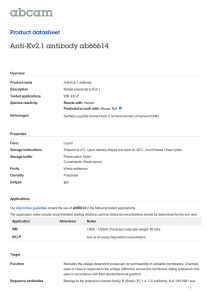

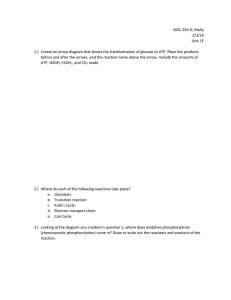
![Anti-Phosphoserine antibody [3C171] ab17465 Product datasheet 1 Abreviews 2 Images](http://s2.studylib.net/store/data/012661843_1-cf30f7cdd8fba511ca130702d73e7f10-300x300.png)
